Vol 5 No. 32 TROPIC LIGHTNING NEWS August 24, 1970
Index
Dreadnaughts Inflict Heavy Casualties
Enemy Wilts Under Tanker Pressure
By SP4 FRANK MORRIS
TAY NINH - The 25th Division's 2nd Battalion, 34th Armor had a busy fortnight
recently when they took part in several ambushes and in an operation which
resulted in the death of 21 enemy.
On Monday on the first week, Alfa Company Dreadnaughts reacted to an ambush
on an artillery convoy near Thien Ngon. In that action, they assisted the 49th
ARVN Regiment which killed 11 enemy.
The following day, the tanks of A Company were again called in to react to
another possible ambush of a convoy in the same area. This time the tanks
triggered the ambush and resulted in light casualties to the tank company, with
unknown enemy losses.
The same day, Alfa Company was again called upon to react to Civilian
Irregular Defense Group, (CIDG) elements who were pinned down by an undetermined
enemy force. Alfa Company extracted them from the contact, again killing an
undetermined number of enemy and suffering fiery light casualties.
With the command group now on the scene, a unique assembly of forces was being
formed to rid the region of the enemy. It was called Task Force Kidwell, after
Dreadnaught commander, Lieutenant Colonel Birtrum S. Kidwell, Jr. It consisted
of elements of the CIDG (Civilian-Regular Defense Group), the 4th Battalion,
49th ARVN Infantry Regiment, and Headquarters, Company A of the Dreadnaughts.
Massive Mission
The international force undertook a massive reconnaissance-in-force mission on
Friday to search out the enemy. The powerful allied forces unearthed four huge
bunker complexes, the largest of which was 70 yards in length and contained
stockpiles of commo wire. The bunkers were heavily fortified and had seemingly
withstood air strikes, heavy artillery and tank fire. All of the bunkers were
completely destroyed.
According to Major David P. Miller, Dreadnaught operations officer, the
operation was a success. The combined forces during the period killed 21 enemy
and took four detainees, while the allies suffered only minor casualties.
In another recent quick reaction, the 2nd Battalion, 34th Armor moved into an
area one and a half miles southwest of Fire Support Base Lanyard at mid-morning
to support CIDG in contact near the Cambodia border.
A search revealed five NVA soldiers had been killed by the CIDG.
Pedal Power Play
Bike Commandoes Strike
By SP4 KRIS PETERSEN
FSB KIEN -- Several 25th Division bicycle-commandoes recently outdid even
their division's history of lighting-like mobility and resourcefulness, when
they used "pedal-power" to round up a group of suspected communist sympathizers
and uncover a rice cache.
While in a night defensive position near here, a small element of Charlie
Company, 3rd Battalion, 22nd Infantry Regulars, heard voices and a transistor
radio playing in the distance.
The next morning, a company-sized sweep of the area discovered approximately
20 Vietnamese children who were cutting bamboo shoots along the side of the
road.
Round-Up
"We rounded them up, put them on their bicycles and sent them on their way,"
said Captain James K. Skiles, of Marshall, Tex., company commander.
At that moment, farther down the road, the company spotted a moderate-sized
group of women suddenly dart out from the jungle onto the road. As the GIs
attempted to stop them, the women began to run.
Seeing this, three Tropic Lighting troops hopped on bikes and pedaled in hot
pursuit, noting that the women were throwing small bags of rice and other
foodstuffs away as they ran.
"We intercepted some of them about 500 yards away, but our bikes broke down
in the chase," said Staff Sergeant Albert S. Fugit, of Stony Point, N.Y.
A shuttle system then was set up, using a LOH (Light Observation Helicopter)
that was in the area to transport three men at a time down the road to help the
"Cycle Commandoes" apprehend the large group of women and children.
The remainder of the company followed the road, picking up the goodies the
Vietnamese had left behind.
"It looked like a bunch of kids in an Easter egg hunt back in the world,"
recalled one Regular.
Large Cache
The discarded bags of rice led to the discovery of a much larger cache. In
his search, Sergeant William E. Connery noticed what seemed to be an unfinished
bunker complex off the road. The complex turned out to be a cache containing
3,300 pounds of rice, and a variety of food items, including tobacco, flashlight
batteries, soap, fish and a hundred pounds of fresh meat.
The Vietnamese were detained, and later turned over to local Vietnamese
officials for interrogation.
"The worst part of the whole ordeal was trying to convince the women to get
on the choppers without their bicycles," said Private First Class Melvin A.
Bushong, of Beach City, Ohio.
Tomahawks Find Soup Instead of the Enemy
By SGT MIKE KEYSTER
XUAN LOC - A platoon of the 25th Division's Bravo Company, 4th Battalion (Mech),
23rd Infantry, working with a Regional Force (RF) element recently spotted and
tracked three NVA. Instead of contact, they found soup.
Working about 20 miles south of Xuan Loc district, the Tomahawk-Vietnamese
force ran into a fresh trail in thick jungle while conducting ground
reconnaissance operations. Sergeant Gary Eagleton, of Woodland, Calif., said
the Bravo forward element suddenly saw movement near a hill.
"Our Kit Carson scout tracked the enemy through the thick jungle in the area,
but finally lost them," he said.
Just after losing sight of the NVA, however, the combined forces discovered a
large cache in a bamboo thicket on a small hilltop. Specialist 4 David Vann, a
squad leader from Detroit, said: "We were almost on top of the hill when we ran
into a small enemy base camp with three bunkers and a large hootch."
The two platoons swept the camp on line and found a partly buried cache of 50
pounds of beans, 300 pounds of Chinese soup, 550 pounds of rice, 150 pounds of
Vietnamese soup, six pounds of salt and three NVA ponchos.
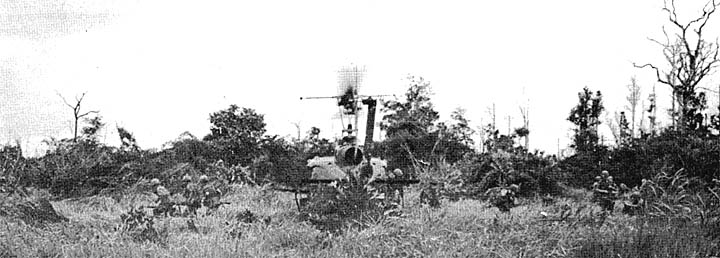 |
| MOVE OUT -- Warriors of the 25th Division's Bravo Company, 2nd Battalion, 12th Infantry move to cover after being inserted into area by chopper. (Photo By SGT Mark Rockney) |
Page 2 TROPIC LIGHTNING NEWS August 24, 1970
Decorated
| SILVER STAR | |
| CPT Byron W. White, Co D, 2d Bn, 12th Inf 1LT Leroy Werkoven, Co B, 1st Bn, 5th Inf SGT Richard E. Farrow, Co B, 1st Bn, 5th Inf SGT James R. Owens, Co A, 1st Bn, 5th Inf |
SP4 Verl Bagley, Co C, 1st Bn, 5th Inf SP4 Richard S. Fordyce, Co D, 2d Bn, 12th Inf SP4 Daniel Kleven, Co D, 2d Bn, 12th Inf |
|
SOLDIER'S MEDAL |
|
| CPT Byron W. White, Co D, 2nd Bn, 12th Inf | |
|
BRONZE STAR (VALOR) |
|
| CPT James T. Ellis CPT Johnny D. Garrard CPT Nelson E. Rogers 1LT Thomas G. Harris 1LT Eugene C. McCaffery 1LT Philip E. McMahan 1SG Arcadio Torres SFC Wayne O. Bardwell SSG Jaward L. Buckalew SSG Douglas Evans, C Trp SSG Teynaldo Garcia SSG Jerry Grace SGT Jthn J. Bleyer SGT Dnnie L. Davidson SGT Rchard Gallagher SGT Janes W. Griffin SGT Abel Rivera SGT Jfrry L. Roth SGT Janes Scullen Jr SGT Chris Vacek SP5 John R. Brejla SP4 Ronald E. Abrams SP4 Harold E. Alexander SP4 Lawrence D. Allen Jr SP4 Pul Armstrong SP4 Leslie L. Beaty SP4 Francisco Berrios SP4 Boyd Butterfield SP4 Chris A. Chambers SP4 James Collins SP4 William R. Cox SP4 Michael Dempsey SP4 Arthur R. Derks SP4 James Hager, SP4 Eddie G. Harris SP4 Robert Jacky, SP4 George L. Kampas SP4 Albert W. Kirchmer |
SP4 Karl W. Kock Jr SP4 Willis Kruger, SP4 Pablo G. Leal SP4 Dwight E. Lutsko SP4 James Madden SP4 Lyle Mendicino SP4 Mante L. Ortman SP4 Antonio M. Perez SP4 Donald Quintanilla SP4 Gregory Sadler SP4 Arik Salazar SP4 Ronald L. Schaeff SP4 Jesse L. Shelton SP4 Richard A. Smot SP4 Carl P. Steude Jr SP4 Larry A. Stevens SP4 Brady W. Traylor SP4 Stephen R. Walker SP4 Albert D. Werder SP4 Jose Yrecheta PFC Michael L. Aunyon PFC Richard R. Bromley PFC Jimmy D. Emberton PFC Garron Hanley PFC Thomas Hils PFC Robert L. Hopp PFC Donald Johnson PFC Ruben Martinez PFC Elmer Massingale PFC Salvantore Misuraca PFC Merlin Oseperook PFC Morris Peebles PFC John T. Pehih PFC Robert Phelps PFC James A. Roberts PFC John M. Robinette PFC Richard H. Vaughn |
Refugees Get Cache Rice
By SP5 TOM BOZZUTO
CU CHI - More than 500 tons of enemy rice was discovered and evacuated by
25th Infantry Division soldiers as they swept through eneny sanctuaries during
the two months of Cambodia operations.
Another 1,000 tons of rice were discovered and either destroyed on the spot
or lost because of bad weather or spillage during rapid evacuation.
The evacuated rice went to Forward Rice Control Points located at Katum and
Thien Ngon. Second Field Force civil affairs personnel logged the amounts
salvaged and loaded it aboard 25th Division Support Command vehicles headed for
the Main Rice Control Point set up at Tay Ninh West.
There the Vietnamese Social Welfare Service for the province, in conjunction
with II Field Force civil affairs personnel attached to province advisory teams,
received the rice shipments and distributed them to refugee centers.
Of the rice received at Tay Ninh West, 280 tons went to refugee enters in IV
Corps. Another 166.25 tons was distributed to refugee centers in Tay Ninh, Hau
Nghia and Long An provinces. The remaining 90-plus tons went to other
distribution centers throughout the II Field Force area of operations.
"The Vietnamese decided we would receive the captured rice and transport it,"
Major David King, Gary, Ind., Tropic Lightning's liaison officer for civil
affairs, said. "And they did an outstanding job of distributing it."
"Because of tactical requirements, and especially the large amount of
transportation that would have been required to handle such a large amount of
rice, it became tactically unfeasible to evacuate all of it," Major Jasper E.
Hunter, Jonesboro, Ark., the division's deputy to the assistant chief of staff
for civil affairs, said.
Hunter said that because of the time limitation imposed on the maneuver
battalions because of the impending rainy season, political requirements and the need to
maintain the element of surprise, units had to constantly be on the move.
"We simply didn't have time to evacuate all the rice we found," he said. "If
the units had made attempts to evacuate all the rice it would have been
impossible for them to search as large an area as they did during the Cambodia
operations."
| WHICH WOULD YOU BET YOUR LIFE ON? - A dirty weapon here in Vietnam is no joke. Keep a clean machine, and when cleaning it, check all parts of the bolt assembly for chips, cracks, or rust deposits. Lubricate all moving parts of the rife with LSA, and use it sparingly in the chamber and bolt locking recess. Also, clear the gas port on top of the bolt carrier with a pipe cleaner. If this port gets clogged, it may result in a sluggish weapon. Remember: someone's life may depend on that rifle working. (Photo by SP4 Joe Loper) |
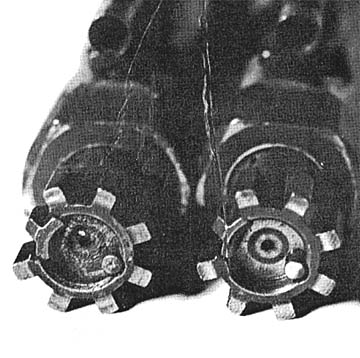 |
Tropic Lightning Tots
The Commanding General Welcomes
The Following Tropic Lightning Tots
To The 25th Infantry Division – As
Reported By The American Red Cross.
Born To:
| July 26 SGT Carl E. Russ Co C 4th Bn, 9th Inf, girl Maj James W. White, 277 S&S Bn, boy July 27 SP5 Bobby R. Lewis, HHD 86th Sig Bn, girl July 28 1LT David L. Phillips, HHC 2nd Bn, 14th Inf, boy 1LT Paul E. Wimble, HHC 3rd Bde, boy July 29 SGT William H. Messengil, Co B 4th Bn, 9th Inf, boy PFC Joh Clifton Jr, Btry D 2nd Bn, 34th Armor, girl July 31 PVT Arthur Sanechez, 25th Repl, boy SP4 Richard J. Van Wyns Berthe, Co D, 2nd Bn, 14th Inf, boy Aug 1 PFC Sommel L. Woods, Btry A 2nd Bn, 34th Armor, girl |
Aug 1 SP4 Jose Duran, Co C, 65th Engr, boy Aug 2 SP5 Richard Bonham, 25th MP Co, girl Aug 3 SP4 Gregory Green, Co B 2nd Bn, 34th Armor, girl SP4 Brooky Gray, Btry D, 3rd Bn, 13th Arty, girl SP4 William Potter, HQ 3rd Bn, 4th Cav, boy Aug 4 SP5 John A. Huber, HHC 588th Engr, girl 1LT James M. Feel, HHC 3rd Bde, girl Aug 5 SP4 William M. Lane, 25th Admin Co., boy SP4 Richard Walker, HQ 65th Engr, girl Aug 6 PFC James Garza, 25th MI. Co, boy SGT Arthur L. Gillis, A 3try, 2nd Bn, 77th Arty, girl |
The TROPIC LIGHTNING NEWS is an authorized publication of the 25th Infantry Division. It is published weekly for all division units in the Republic of Vietnam by the Information Office, 25th Infantry Division, APO San Francisco 96225. American Forces Press Service and Army News Feature materials are used. Views and opinions expressed are not necessarily those of the Department of the Army. Printed in Tokyo, Japan, by Pacific Stars and Stripes.
MG Edward Bautz, Jr . . . . Commanding General
MAJ Robert E. Kelso . . . Information Officer
1LT John Caspari . . . . . . . Officer-in-Charge
SP4 William M. Lane . . . . Editor
SP4 Scott Watson . . . . . . Assistant Editor
SP4 Joseph V. Kocian . . . Production Supervisor
BATTALION CORRESPONDENTS
|
SGT Mike Keyster SP4 Tom Benn SP4 Frank Salerno PFC Dan Lowry SP4 Greg Duncan SP4 Rick Erickson SP4 Ed Toulouse SGT Mark Rockney SGT Mike Conroy SGT William Zarrett SGT Daniel House |
4/23 7/11 2/22 2/27 2/27 2/14 2/12 2/12 3/4 Cav 4/9 4/9 |
PFC Irwin Polis SP5 Tom Watson SP4 William McGown PFC James Stoup SGT Derr Steadman SP5 Doug Sainsbury SP4 James Duran SGT Jack Strickland SP4 Dan Davis SP4 Kris Peterson SP4 Frank Morris |
269th 725th Divarty 65th Engr Discom 2/77 3/13 1/27 1/27 3/22 2/34 |
Page 3 TROPIC LIGHTNING NEWS August 24, 1970
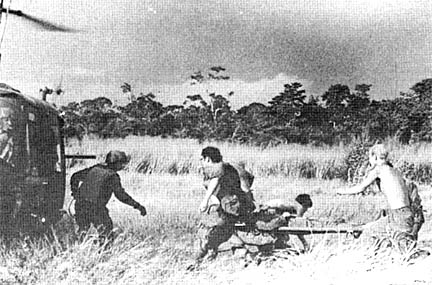 |
DUSTOFF -- Running to get their litter aboard a chopper, men of the 25th Division's Alfa Company, 1st Battalion (Mech), 5th Infantry don't waste any time. The Bobcats were in contact with the enemy in Xuan Loc District. (Photo by 1LT Martin E. Webb) |
Life on Nui Ba Den
Mountain Men Speak Out
NUI BA DEN -- Several years ago, due to the massive area of operations of the
25th Infantry Division, it became necessary for the division's 65th Engineer
Battalion to build a radio relay station atop Nui Ba Den, the largest and most
barren mountain in the area.
Since that time, a tour on the "Black Virgin" has become one of the least
desired jobs among the engineers.
"It is an interesting place to visit for anyone who has never seen or been on
the Black Virgin Mountain. But no one in their right mind would want to stay
there very long," claims Private First Class Mick Calaci, of Vernon, Conn.
The mountain, which rises roughly 3,100 feet above sea level, is a huge
defoliate granite stone. The primary duty of the engineers on the mountain is
to communicate between the battalion headquarters and Alfa Company, as well as
any elements that do not have direct communications with each other.
Evidently, not all the men who work on Nui Ba Den think it's bad duty.
"It is good duty here because things are more relaxed," said Specialist 5
John Dereda, of Atlantic Beach, N.Y., the team chief. "SOP's are not as
rigid
as in Cu Chi (the division rear area), and as long as we get the job done we are
usually on our own."
Pulling a shift on the radios means sitting in a cubical about six feet
square and trying to listen to your push with about twenty other radios
squawking away in the same room.
According to Private First Class William Rose, of Jersey City, N.J., "About
the only things we have to look forward to up here are the chow, which is not
too bad, the mail, and returning to the peace and quiet of our sleeping bunkers
after a long 12-hour shift."
Because of a recent reorganization of the 25th's AO, it has become necessary
for the engineers to set up another signal retransmission station in order to
support Bravo Company in their operations south of Xuan Loc.
A few weeks ago, Specialist 5 John Buie, of Panorama City, Calif., and
Private First Class Wally Gibson, of Dallas, left Cu Chi armed with generators,
radios, antennas and other signal equipment to establish the station atop the
2,800 foot Nui Chau Chan.
Life on Nui Chau Chan is very similar to that on the Black Virgin Mountain.
"We have it a little better here than on Nui Ba Den. We have a cement
basketball court and movies several times a week," said Gibson.
It's Happening
YOU MAY LOSE A LITTLE SLEEP OVER THIS...Camp Alpha folk would like us to pass on
the word that if you are of a mind to try stretching your R&R by arriving at the
Camp a few days before your flight and staying on for a few days after your
return, you'd better change that mind. There just aren't enough billets at
Alpha and since the R&R center at Cam Ranh Bay closed, there are just that many
more soldiers passing through. You will get a bunk the night before your
flight, and one the night after you are returned to captivity. Before and after
that, you'll have to find another hotel.
DELAY (GLUG) IN ROUTE ...A DC-8, carrying several tons of letters and packages
from the world to Vietnam, ditched in the Pacific recently, breaking apart in
the water at a depth of six feet. The letters and packages went swimming. Mail
recovery operations have succeeded in recovering some of the stuff and that
which can be identified will be forwarded after a hot spin in a clothes drier.
If you know that someone sent you a special letter or package and it has never
arrived, you may well bet that the piece was on the fateful aircraft. Claims
may be made, but they must be initiated by the sender and not before August 28.
Be sure to inform them if you have not received the expected mail by that date.
YOU CAN'T LEAVE UNLESS YOU'RE SHORT ... If you're planning on thumbing a ride on
an R&R plane for leave, the word is that if you haven't spent at least 11 months
in country, you won't get a seat. And they don't sell tickets for standing
room. Advice to the leavelorn: hang tight until you're in your last month.
OUR FIRST--AND PROBABLY LAST--HAPPENING CONTEST ... We have been extremely
impressed with the imagination of the American fighting man when it is directed
toward a subject very dear to his neck: his DEROS calendar. So in the name of
fine art and for purposes of spreading the wealth, we invite you to submit your
original versions of the DEROS calendar to the Division Information Office. All
entries will be judged by a very select list of shorttimers and winners will be
insured a place among the immortals by having their works of art reproduced in
the "Tropic Lightning News." One hint: we will not print dirty pictures. But
if you have a calendar that fits that category, send it along anyway. It will
look good on my wall.
A SHAGGY SNAKE STORY...Don't be surprised if you wander into the offices of the
25th Division's 20th Preventive Medicine Unit and are confronted by a 10 foot, 6
inch python. A rock python to be exact. Just say "nice Martha" and everything
will be all right. "She's very gentle," says Specialist 4 Stanley R. Copeland
of Kansas City, Mo., who should know. Copeland likes to wrap Martha around his
neck and stroll about the post. We asked Copeland how one tells a male python
from a female. "Very inaccurately," Copeland replied. "Martha is really a boy
snake. But we didn't discover that until last week. For three years we thought
he was a girl."
Martha eats twice a month. His menu consists of a rat or two, a chicken and
perhaps a duck. While the men of the 20th have taken kindly to Martha, there
are those at Cu Chi who would prefer to keep their distance. One day recently,
Copeland and Martha were taking an afternoon walk, when the driver of a
deuce-and-a-half full of mama-sans started at the sight of them and drove the
truck into a ditch. Martha didn't even bat an eye.
Charlie Flees Bunker Complex, Would Rather Write Than Fight
"Americans, if you are intelligent leave this area. Advancing will mean never
seeing home again." "The Liberation front of South Vietnam."
This was the greeting Bravo company 2nd Battalion, 12th Infantry found
recently while on a search and clear operation north of Dau Tieng.
A scout dog's alert nose led the element to an extensive bunker complex.
"The first thing we saw was the sign attached to the outside of a bunker,"
recalled Specialist 4 William Dobie of Miles City, Mont. "But it didn't alter
what had to be done, so we continued searching very cautiously," he added.
Apparently the enemy wasn't far behind his warning. According to Kit Carson
Scout Tac Huyng-Van, approximately 30 enemy had cleared the area only minutes
before. The Warriors found rice cooking on a fire with two large piles of
firewood nearby.
"They had been here some time," said Captain Ted Taylor, of Weston, W. Va.
"And, they were in the process of digging a well that reached a depth of 80 feet
without striking water."
Booby Trap
By SGT MIKE KEYSTER
XUAN LOC -- In recent operations 20 miles southeast of Xuan Loc district, a
recon element of the 25th Division's 4th Battalion (Mech), 23rd Infantry, found
that alertness possibly saved several lives.
The Tomahawks, while conducting ground searches, came across a newly
abandoned enemy base camp, which included several bunkers, hootches, and eating
quarters. Nothing significant was found in the camp.
However, the surrounding area and several trails that ran from the camp were
slowly searched. Within 50 yards of the camp, the Tomahawks luckily discovered
a well-camouflaged booby trapped U.S. grenade just off a trail.
A small vine, of which there were many in the area, was ingeniously hung
across the trail and wrapped around the grenade fuse so that it could be jerked
easily by a passing GI.
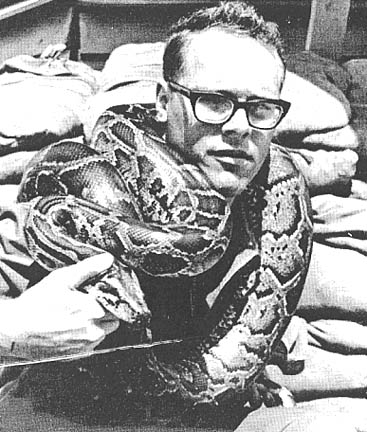 |
MEET MARTHA -- Wearing Martha the python like a snake stole is Specialist 4 Stanley R. Copeland of the 25th Division's 20th Preventive Medicine Unit. If you squeeze Martha, she'll squeeze back. (Photo by SP4 Joe Loper) |
Page 4-5 TROPIC LIGHTNING NEWS August 24, 1970
Up in Air with Men from Down Under
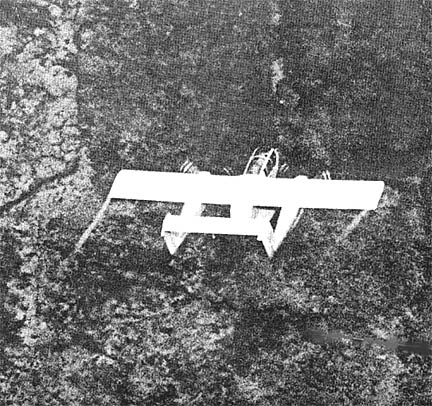 |
| Photos and Story By SP4 RICH DOMBROWICKI |
CU CHI - As common as clouds in the skies above Cu Chi are swift, nimble
aircraft known as OV-10 Broncos. Not so common are one group of Bronco pilots.
Aiding their allies from the land of stars and stripes is a contingent of airmen
from the lands of kangeroos and koala bears.
The up-in-the-airmen from down under (Aussies and a lone New Zealander) are
attached to the 25th Infantry Division Tactical Air Control Party in a
cooperative program between their countries and the United States.
The program is designed to afford combat training for the pilots while they
help the U.S. effort through their participation in air missions.
"We are all experienced air-strike pilots," said Flight Lieutenant Ray Butler
of Sydney. "Our tour here is eight months and the combat experience we gain is
invaluable. We all volunteer to come."
Australian military training is oriented toward jungle warfare.
"This differs from the American concept which traditionally stresses the
European or open area fighting style," said Squadron Leader Graham Neil, also
from Sydney. "My government believes in defense in depth. That is why we are
here, helping our allies while practicing our skills over jungle terrain."
The program has been in effect since 1966, although with the 25th Division
only since last November. The men all receive two-weeks' training at Da Nang
flying the OV-10 aircraft.
During the recent Cambodian operations, the down under personnel were really
kept on the go.
"We took over the 3rd Brigade's area of operations while the U.S. pilots flew
Cambodia missions," said Flight Lieutenant John Denton, the lone representative
of New Zealand. "Now we're flying for the 2nd Brigade, so we've been all over."
The Bronco pilots feel that their contributions are just as important whether
they fly recon missions or actual air strikes.
"The infantrymen like to see us up there," Denton added. "Our mere presence
in the area is often enough to deter the enemy and save somebody's life."
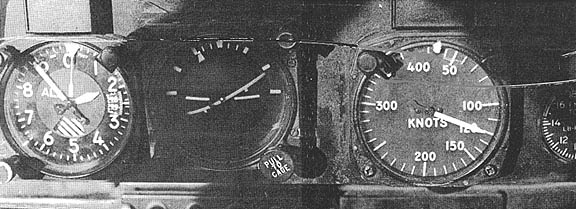 |
| HOW FAST, HOW HIGH - Gauges of U.S. Air Force OV-10 Bronco in flight reflect some of its capabilities. These dials indicate (L to R) altitude, banking angle, speed and power. The twin turbo-prop planes are being flown by members of the Royal Australian and New Zealand Air Forces in support of the 25th Infantry Division. |
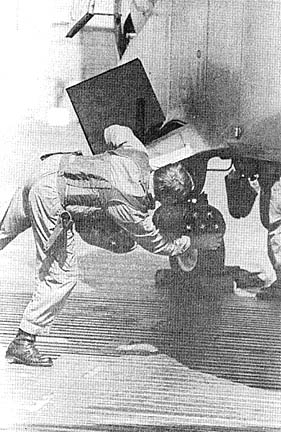 |
ROCKET PODS - Royal Australian Air Force Pilot Flight Lieutenant Ray Butler makes pre-flight check on rocket pods of OV-10. Each Bronco carries a total of 28 rockets in four pods. |
| FINAL ADJUSTMENT - A ground crewman adjusts back straps of ejection seat while Royal Australian Air Force Flight Lieutenant Ray Butler straps himself in. |
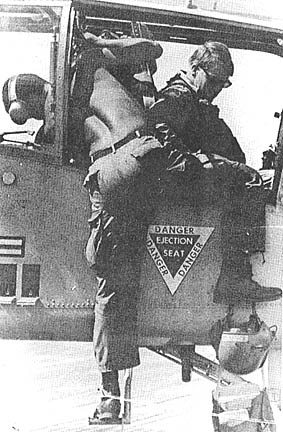 |
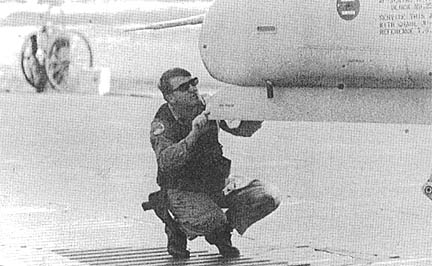 |
ONE LAST CHECK - Nose assembly and landing light of U.S. Air Force FAC aircraft are given pre-flight check by Flight Lieutenant Ray Butler. Butler, of Sydney, flys missions in support of the 25th Division near Cu Chi. |
| STRAIGHT AHEAD - Ground crewman guides U.S. Air Force Bronco to parking position at Cu Chi airfield. The planes are being flown by men of the Royal Australian and New Zealand Air Forces in support of 25th Division operations around Cu Chi. |
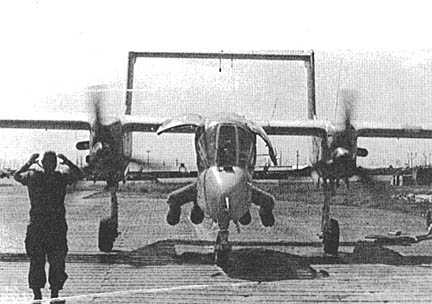 |
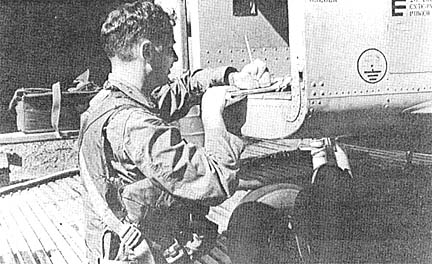 |
PAPER WORK - Post-flight report on U.S. Air Force Bronco is made out by Royal New Zealand Air Force Pilot Flight Lieutenant John Denton of Whangarei, N.Z. Bronco pilots fly both reconnaisance and air-strike missions. |
Page 6 TROPIC LIGHTNING NEWS August 24, 1970
| IN THE SHADE OF THE OL' RUBBER TREE -- Recon Tomahawks of the 25th Division's 4th Battalion (Mech), 23rd Infantry take a short break in a rubber plantation while on operations 20 miles south of Xuan Loc. (Photo by SGT Mike Keyster) |
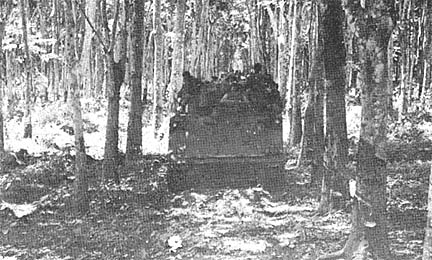 |
Black Belt
Instructor
Cu Chi Has Karate Class
By PFC PATRICK F. MURPHY
CU CHI - Karate, an ancient oriental fighting art, is fast becoming a popular
sport throughout the western world. A prime example is the course now being
conducted at the Special Services exercise room here.
Organized by Staff Sergeant Doug Landies of the 18th Military History
Detachment, the group is presently under the direction of Kim Sun Choi. Kim, an
employee of Pacific Architects and Engineers, is rated a fourth degree Black
Belt on a scale ranging from one to ten.
A native of Korea, Kim teaches the Tae Kwon Do (Korean) style of Karate.
"I view Tae Kwon Do as both a sport and method of self-defense," he said.
"And its both a mental and physical exercise."
Of the seven students presently enrolled, Landies, of Cleveland, is the most
experienced. A sixth degree Green Belt, he has been an avid devotee for the
past nine months.
"I got into this back in the States and decided to follow it up when I got
here. I asked around to see if anyone was interested and hence the classes,"
explained Landies.
"Depending on your viewpoint, Karate can be a sport, an art or a means of
self-defense, - or a combination of all three," said Landies.
Purists, on the other hand, regard it with the respect due a religion. For
many, it becomes a way of life. This is not uncommon in many oriental
countries.
While there are various styles of Karate, Tae Kwon Do (Korean) and Kampo
(Chinese) continue to dominate as the most popular with western fans. It is
currently estimated that as many as four million people are taking instruction
in the U.S.
Although the Cu Chi group is small, interest is picking up among GIs who hear
of the course. All those enrolled (with the exception of Landies) have had
little or no experience prior to signing up.
Dreadnaughts Begin Vehicle Upkeep Test
By SP4 FRANK MORRIS
TAY NINH -- The 2nd Battalion, 34th Armor has initiated a unique program to
promote higher efficiency in the upkeep of their numerous track and wheeled
vehicles. Awards are given monthly to the best-kept vehicle in the battalion.
The program is the brainchild of Sergeant First Class Walter Souther from Ft.
Worth, Tex., the battalion maintenance sergeant.
The vehicles are broken down into three classes: (I) utility (one-quarter and
three-quarter ton trucks), (2) trucks (two and one-half and five ton vehicles)
and (3) tracks (all track laying vehicles).
Of these, one class is chosen by the battalion commander to compete for the
award during the following week. His choice is not announced until one week
before the inspection.
The different units of the battalion then prepare all the vehicles in this
class for a thorough inspection. They select their best vehicle for the
competition.
A maintenance team is brought in from the 725th Maintenance Battalion to
search in every nook and cranny of the vehicles for gigs.
The soldiers who operate the truck or man the track receiving the fewest gigs
are awarded a sum of money and a three-day R&R at China Beach. The winning
unit's name is inscribed on a plaque displayed in a prominent place at battalion
headquarters.
Americans Contribute To Chapel
DUC HOA -- Tropic Lightning chaplains recently presented $1,000 dollars worth
of piasters to Vietnamese chaplains here to build a chapel.
The money was collected at 25th Division and 3rd Brigade, 9th Division
services during the past several months. Vietnamese Catholics and Protestants
will share the money on an equal basis, Lieutenant Colonel Roy Peters, the
former 25th Division chaplain said.
The presentation was made by Major General Edward Bautz, Jr., the 25th
Infantry Division commander, during a ceremony here. The gift was accepted by
Major General Nguyen Xuan Thinh, the 25th ARVN commander.
Ask SGT Certain
DEAR SGT CERTAIN: In the August 3rd Tropic Lightning News, there is a
picture of a truck of artillerymen arriving in Tay Ninh Base Camp. However, the
way the sign reads they are apparently backing in. What's up?
Sweet Corporal
DEAR SWEET: Correspondent, SP4 Tom Benn who wrote the article was not available
for comment, but I got hold of PFC Tad Ferndock, an expert in such matters --
PFC Ferndock has been stationed in Nam for eight years. Ferndock told me that
all forward gears on the deuce and a half had busted, but the guys decided
they'd get to Tay Ninh or bust (PFC Ferndock used that word a lot.) Anyway,
they traveled the last 12 and one half miles in reverse gear. This caused
trouble on one-way bridges. Since bridge guards couldn't determine which way
the truck was going they had to stop traffic in both directions. VC attempting
to mine the road were also foiled, as they laid the mines where the truck had
been, rather than where it was going.
DEAR SGT CERTAIN: Some time ago, the powers that be in in my unit threatened to
serve us hot dogs made from the critters that hang around the mess hall if we
soldiers didn't stop dropping them tid-bits. Last Thursday night, I think they
made good on their promise. Can you verify?
N.D. Gestion
(Unit name withheld on reqeust)
DEAR N.D.: Checking through the records of your mess hall, I do find an entry
on the day in question identified only as "mystery meat." Also, as I was
leafing through the books, a mess hall bulletin fell onto the floor. The
bulletin ordered all cooks to fall out in full web gear with weapons on that
Thursday morning at 0600 hours. Although I can't conclusively prove that
"mystery meat" was local hound, I will definitely agree with you that the meal
didn't cut the mustard.
Page 7 TROPIC LIGHTNING NEWS August 24, 1970
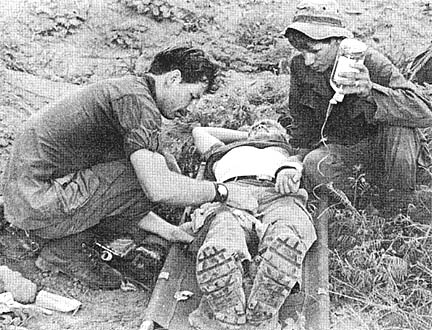 |
WORKING QUICKLY AND EFFECTIVELY - Specialist 4 Orville Rickard, from Martinsburg, West Va., (at left) and Specialist 4 Richard Byers, from Lodi, N.J., (at right), combat medics of the 2nd Battlaion (Mech) 22nd Infantry, treat a wounded infantryman for chest and leg wounds. |
| SHOT TIME -- Private First Class Thomas Greenblatt, a combat medic for Triple Deuce, from Nashville, Tenn., gives another Triple Deuce infantryman a needed shot. |
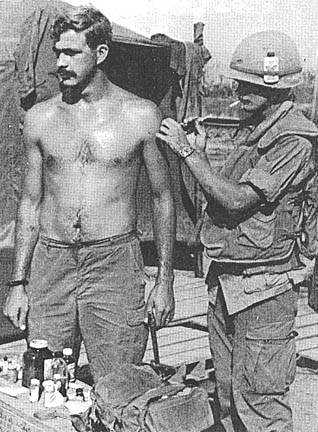 |
The Combat Medic Is Everybody's Friend
By SP4 FRANK SALERNO
CU CHI -- He doesn't get the infantryman's headlines, but he deserves them.
He's not an 11 Bravo but he's admired by them. He's invaluable. He's the
combat medic.
He rides the armored personnel carrier of the 2nd Battalion (Mech) 22nd
Infantry, on all operations. When the men dismount to check out an area, he's
searching like everyone else.
When arriving at a night laager position, he is there to help out too. From
digging a fighting position to setting up protective screens in front of the
tracks, he's there sweating and cussing and getting grimey just like everyone
else.
After supper the men going on an ambush patrol get ready. He does too -
checking his gear which includes his all-important first aid bag.
He's as nervous as anyone else is in contact, but yet he works quickly,
risking his life to comfort and save his wounded buddies.
He's a traveling drug store, with medication for everything from headaches to
cuts and sores.
When the men finally get some free time after a busy day his job continues:
bandaging, soothing, comforting.
He's like every other Triple Deuce infantrymen. But - he's the combat medic.
| GETTING PREPARED - Specialist 4 Herschel Cook, a Triple Deuce combat medic, gets his weapon, ammo and all important First Aid bag ready in preparation to go on an ambush patrol with his buddies. |
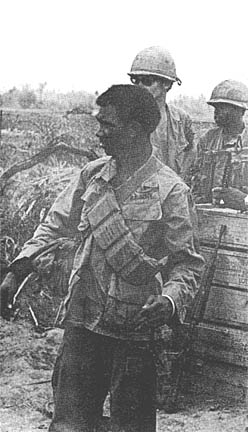 |
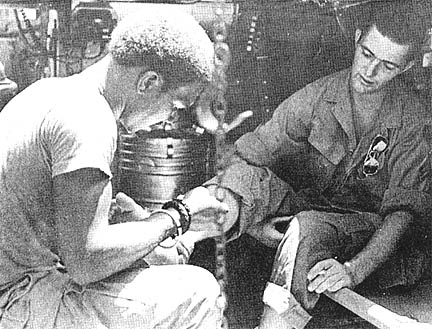 |
MECHANIZED AID STATION - Sergeant Richard Plocinski, from Chicago, gets his twisted ankle bandaged by Specialist 4 Herscel Cook, a Triple Deuce medic, from Waverly Hill, Ga. inside an armored personnel carrier. |
Page 8 TROPIC LIGHTNING NEWS August 24, 1970
President Cites Manchus
Platoon Holds Off NVA
By SGT DANIEL A. HOUSE
CU CHI -- A Presidential Unit Citation for extraordinary heroism has been
awarded to the 1st Platoon, Bravo Company, 4th Battalion, 9th Infantry.
Lieutenant General Michael Davison, commanding general II Field Force,
presented the award to the unit on behalf of the President.
The Manchus earned their distinction for action occurring on January 5,
1968. The platoon was waiting to be extracted from a landing zone near the
Cambodian border when an enemy force of unknown size opened fire on Manchu
positions with rockets, mortars and small arms. The element immediately
maneuvered to the woodline and set up a defensive perimeter.
Supported by mortars and direct fire, the enemy launched a company-size
offensive from the east which the Americans quickly turned back.
The enemy regrouped and hurled themselves at the Manchus in a human wave
attack from the southeast. The platoon once again held firm, calling in air
strikes and supporting artillery within a few meters of their own positions.
Despite heavy casualties and a dwindling supply of ammunition, the besieged
platoon held out and repulsed yet another assault by the desperate enemy from
the west.
During two and a half hours of continuous fighting, surrounded by a hostile,
aggressive force much larger than they, the 31-man platoon suffered the loss of
7 dead and 16 wounded, yet were still able to offer such fierce resistance that
the battered enemy finally had to retreat, leaving behind 60 dead.
Bravo Company is currently operating out of Fire Support Base Tennessee near
the Hobo Woods.
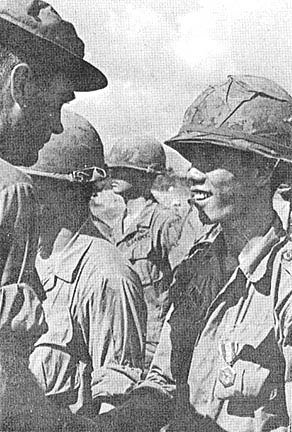 |
ATTENTION TO ORDERS -- LTC R.W. Welsh presents Trang Van Duc, a Kit Carson Scout, the Army Commendation Medal for Valor. (Photo by SGT Daniel A. House) |
When it Rains, On-Time Artillery Pours on Maintenance, Ingenuity
By SP4 TOM BENN
FSB BYRD -- Heavy artillery seldom his much trouble maneuvering across the
Vietnamese countryside during the rainy season. The cumbersome self-propelled
guns simply plow right through thick mud. However, the same can't be said for
the tiny (by arty standards) "one-oh-deuces" of 7th Battalion 11th Artillery.
The 102mm howitzer does not ride on its own tracks like its big brothers, the
155, 175 and "eight-inchers." So it has to be transported behind a truck, which
can lead to problems.
To Cross a Hole
"Once," said Specialist 4 Richard Ofte, a gunner with Bravo Battery, 7/11,
"we were down around the Renegade Woods and had to cross a deep hole in the
road. If we had kept the gun on the deuce-and-a-half, it would have messed up
the barrel something terrible. So we hooked the gun to the back of an APC which
tried to take it off the road and around the hole."
Private first Class Terence Vosepka continued the story.
"The track went off the road and the gun started to tip. We hollered "Stop!"
but he kept going. We kept hollering and each time we did, the gun tipped over
some more."
Three Feet of Water
"Finally," said Ofte, "it just went all the way over. It ended upside down
in about three feet of water."
"The sight," said Vosepka, "is still a little messed up."
The Vietnamese rainy season presents more problems for artillery than just
muddy roads.
"When we were up at Katum," Ofte said, "our gun was out of order just about
every morning because it kept coming out of the soft dirt there."
Big Problem
According to Captain Ronald Yelk, battery commander of Bravo Battery, the
biggest problem during the monsoons isn't with the howitzers at all.
"The biggest problem is that we can't put the ammo bunkers and personnel
bunkers underground where they're safe. The holes just fill up with water."
Constant maintenance and American ingenuity overcomes just about any and all
problems that the seasonal rains present to an artilleryman.
Manchus Pin Arcom On Kit Carson Scout
By SGT DANIEL A. HOUSE
TAY NINH -- In a combined awards ceremony here recently, the 4th Battalion,
9th Infantry Manchus took the opportunity to present Kit Carson Scout Trang Van
Duc with the Army Commendation Medal for his faithful service and heroic action
while serving with his unit in an operation in the Boi Loi Woods last November.
Duc, who is with the second platoon, Delta Company, 4/9, was walking point
for his platoon and through his alertness and quick action, the patrol was able
to organize a hasty ambush when he spotted two NVA soldiers coming down the
trail towards the friendly element.
During the action, Duc exposed himself to the enemy fire several times in
order to place devastating fire upon an additional group of enemy soldiers that
moved up on the Delta Manchus.
In both cases, it was Kit Carson Duc who spotted the enemy forces and alerted
the friendly forces to their presence.
Tough Sarge Is Up For Infantry
By SP4 FRANK SALERNO
CU CHI -- In the annals of modern combat history, there have been a number of
heroes of considerable fame. In World War I, there was Sergeant York. In World
War II, there was Audie Murphy, who later on did his fighting on movie sets.
In the 25th Division, there is a new hero in the making. In fact, this hero
has been in the making since the Korean War. He is Sergeant Gilbert Paris, from
Ownsburg, Ky., currently serving with the 2nd of the 22nd (Mech).
"I got my first two purple hearts during the Korean War," Paris said. His
unit fought such famous battles as Old Baldy and Pork Chop Hill.
"The fighting in Korea was much more intense than it is here," Paris went on.
Always 11-B
The sergeant, now serving his third Vietnam tour as an 11-Bravo, has
amassed
a total of 21 battlefield decorations. "I'll always stay 11-Bravo," he said,
"because I like to be where things are going on.
"Besides, I feel that there isn't any other job in the Army that presents
more of a challenge than the infantry."
During Paris' first tour in 1966, his platoon once accounted for 112 enemy
dead in a single action.
"We were a platoon-size ambush patrol of the Americal Division at Khe Sanh.
An enemy force of undetermined size walked into our trap.
"After initially engaging them, we estimated that the hostile force was quite
large. We called in artillery and gunships and the next morning saw the
results.
Part of the Job
He has suffered numerous shrapnel wounds on his back and face, but discounts
them as "Just part of the job."
Paris has seen a number of changes here since 1966.
"Water has become more plentiful and living standards have improved for the
troops," he said. He also noted that Vietnamization is really working.
Paris is due for stateside leave shortly. Then it will be back to Vietnam
once again, this time as an ARVN adviser.
For Paris, there is no other life.
| "WHY DON'T THEY MOW THE LAWN?" -- PFC Andrew Work of Hays, Mo., humps a light machine gun as men of the 2nd of the 22nd (Mech) take to ground after heavy monsoon rains. (Photo by PFC Nick Haren) |
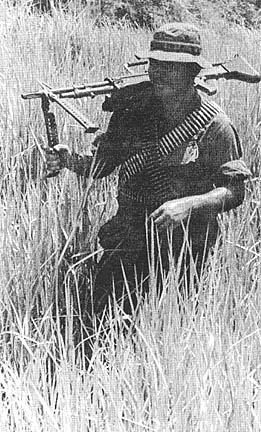 |
Thanks to:
Andrew Beiler, 1st Bn., 27th Inf.,
for sharing this issue,
Kirk Ramsey, 2nd Bn., 14th Inf. for creating this page.
This page last modified 05-28-2006
©2006 25th Infantry Division Association. All rights reserved